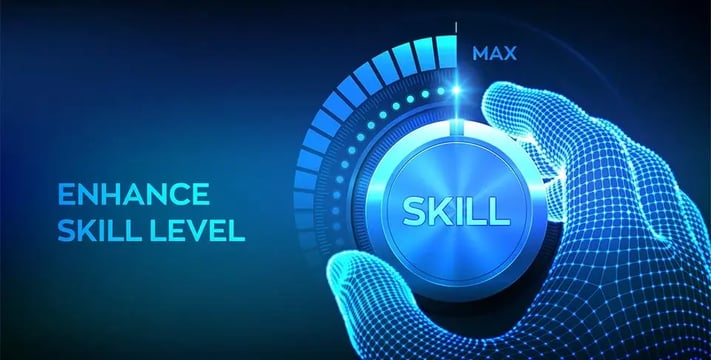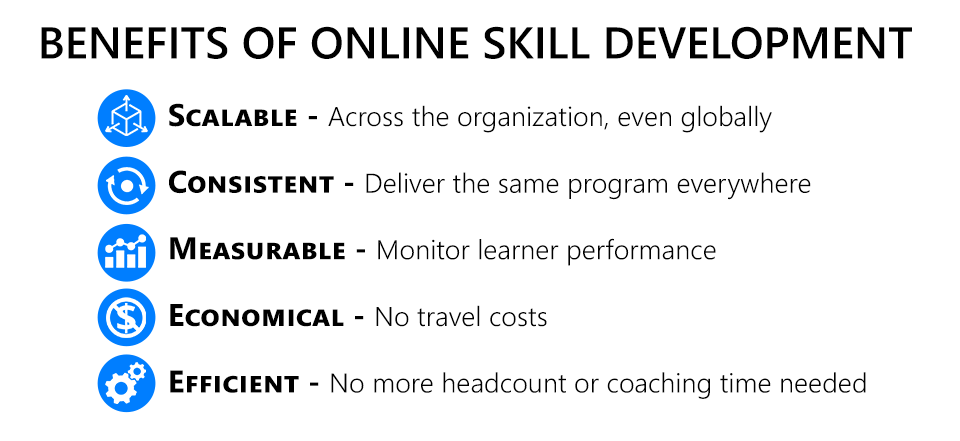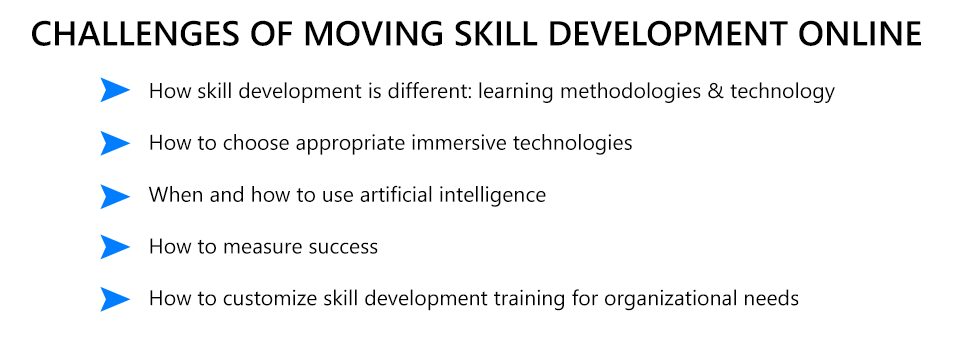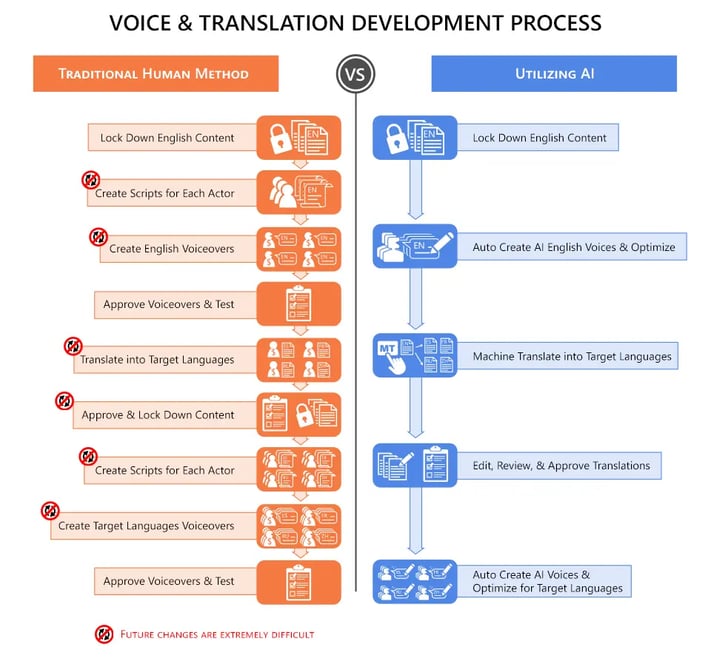
Skill development requires intensive interaction, and typically involves one-on-one coaching. Therefore, moving this training online requires a different approach and different tools. E-learning tools, while effective at enabling knowledge acquisition, are woefully inadequate for the task. Good news! There are powerful immersive technologies that effectively move skill development online. In this article, we’ll explore them.
Benefits and Challenges of Moving Skill Development Online
The benefits of moving skill development online are significant and compelling. Unfortunately, the challenges of doing so effectively are equally significant. This article provides a road map on how to address these challenges to create effective skill development programs online.
We will be focusing here on skill development that applies largely to thinking and conversational skills in areas like leadership, sales, customer interactions, and even mentoring doctors.


How Skill Development is Different: Learning Methodologies & Technology
Effective skill-development coaches intuitively use cognitive apprenticeship learning methodology every day. It’s an apprenticeship for thinking skills. At its roots, it’s about extracting the “expert” mental models of high performers (how they make decisions), and coaching learners through practice, to recognize the patterns in these models and integrate them into their own mental models for better performance (more on this here). This process is an inherently experiential, learn-by-doing approach. This learning approach is very different from traditional training for knowledge acquisition.
When skill development is moved online, it is often relegated to the e-learning teams that do the existing training. These groups are adept at knowledge acquisition training. Videos, webinars, virtual instructor-led training (VILT), and flat e-learning simulations are designed to close knowledge gaps. Skill development however, is designed to close performance gaps through behavior change. For this task to move online, we need more immersive and intelligent technologies that can create a virtual experience of real practice with embedded, personalized coaching.
How to Choose Appropriate Immersive Technologies for Skill Development
For skill development, we set up a situation through conversation, then provide opportunities to make decisions, and embed coaching to navigate these conversations in the most optimal way. When we move this process online, shouldn’t we do the same in the virtual world?
VR Headsets Won’t Help. Do we need a virtual reality headset to look around an environment during these conversations? No. VR is better-suited when the physical environment matters, like in safety training, equipment repair or instructing fire fighters. For immersive conversations, we don’t need to invest in fast-changing VR hardware, or providing contingencies to address cybersickness in about 30% of learners, let alone the cost of building custom VR environments (more on this here). However, we do need to focus on making conversations immersive.
Virtual Conversations Are Hard. Did you ever notice that many 3D simulations rely on one avatar talking to the learner? Rather than a conversation, it’s just a series of monologs. Why not have two characters talking with each other as well as conversing with the learner? This three-way dialogue engages the learner and allows them to hear optimal talk tracks. Isn’t that a better way to hold a conversation? Absolutely!
Technically, having two virtual characters converse is hard. Typically, this requires custom animations for the characters to look at each other or the learner, based on each dialogue line. Yes, this is expensive, and you can imagine how difficult changes are! As an alternative, there are solutions that have humans remotely acting as puppeteers to control the interactions. Besides having to train the puppeteers, this experience does not have the ability to scale at all. While working on National Science Foundation-funded research on immersive technology, our team took a different approach. We developed a conversational engine that automated the process. With this, one can create a dialogue, and the system automatically animates who the characters look at, as well as inserting natural gestures, idles, etc., based on the dialogue lines. This allows conversational dialogues to be scaled within a 3D environment.
Naturally, the next question is about the actual conversation content. How automated can it be? Artificial intelligence (AI) will soon drive our cars, so how about driving our skill-development training? Spoiler alert: While it’s definitely on its way…current AI-powered conversations are not that good, yet….
When and How to Use Artificial Intelligence for Skill Development
Intelligent Dialogue. Siri, Alexa, and Google Assistant can struggle to understand everyday questions, so imagine how hard it is to get an AI to respond intelligently to your specific processes! To train an AI about your company processes, you would need to feed a neural network immense amounts of data and provide feedback, so it can learn. While AI can help with recognizing trends in big data, it’s not ready for skill-development conversations, yet – perhaps in several years.
Instead, we need to develop our own intelligent dialogue. For each performance gap, we capture the behaviors and approaches that subject matter experts use in various situations. Then we can develop decisions and create intelligent responses that become the dialogue. Essentially, we are emulating what it would be like to interact with people and subject matter experts, virtually. This type of automated scripting AI is what video games have used for years to create engaging interactions.
AI Translation. We can now use machine learning to translate content to other languages for global distribution. While not perfect, it’s getting better every day, and can go a long way toward providing a version of the content that can be edited to correct conversational dialog and company-specific terms. Using AI translation avoids the extra coordination and costs associated with external translation. To this end, we’ve integrated machine translation APIs into our process and learning platform, and then added provisions to manage change control.
AI Voices. Another significant challenge for immersive conversations is incorporating realistic human voices. Typically, the content is locked down, scripts are created for each character, voiceover artists record the lines, and the audio files are processed for use. This process takes time, coordination, and is not readily amenable to changes.
Synthetic speech has come a long way, with the introduction of neural voices that utilize neural machine learning to pronounce the phonemes of each word correctly. These voices are almost human. In addition to the voice itself, tools are now becoming available to control emphasis, pauses, prosody (pitch), and emotion, to better emulate a human conversation. By integrating speech synthesis APIs, one can focus on optimizing synthetic voices, which are amenable to change, rather than investing in the cost, time, and rigidity of the human voice approach.
Going Global. The combination of AI voice and AI translation is very powerful, enabling content to go global quickly, with less cost and coordination. The graphic below illustrates the differences between a typical translation project versus one with AI technology. As you can see there is significantly less that can go wrong! After doing it “the hard way” for a long time, we are excited to be moving to a streamlined paradigm with these AI technologies integrated in to one platform.

How to Measure Success
One of the advantages of going digital is the ability to extract data. In skill development, knowing which situations and decisions learners are struggling with (or where they’re doing well) is very powerful. Often though, analytics are an afterthought comprised of a data dump that’s difficult to decipher without a deep dive back into the content. For analytics to be done right, they must be thought through up front, while the content is being created – and you guessed it, often this does not occur. Rather than asking vendors if they can give you analytics, ask them for the details on how their analytics are created. After learning the hard way, we now incorporate performance gap analysis early in our process, and map these gaps to decisions before a simulation is published. In this way, the context of the metrics is built in from the beginning. (More on analytics here.)
How to Customize Skill Development Training for Organizational Needs
Skill development training must be customized to each organization, and the approach needs to be scalable and economical. Many immersive technologies can be applied to overcome the challenges presented here. The one sticking point is that they are often custom solutions: they can create a custom “project” for you. While that “project” may be scalable, doing another one has a similar cost structure. That’s not economical.
A Custom Content Development Platform Approach. After delivering these “custom” projects for many years, one of our team’s goals was to find a way to give customers the power to build immersive conversational content themselves. After all, they are the experts on the content!
Because skill-development methodologies are inherently different, and immersive technologies are much more complex, we knew going in that building this platform was going to be exciting. A key design goal was that the platform needs to be approachable to instructional designers. Another goal was to combine proven “content processes” with the technology, so content creators don’t need to repeat the mistakes we’ve learned from over the years. We will share more on the platform in a future article. If you would like to participate in our beta program of this new platform, please contact us.
Retooling for Remote Work. As companies re-tool to support their remote-working employees, it is important to recognize new technologies that will effectively pull through skill development virtually, and drive new behaviors in the workplace in a scalable way.
About Syandus: Virtual immersive learning technology that transforms knowledge into real-world performance. We immerse participants in realistic virtual situations with one-on-one expert coaching that gives them experience making optimal decisions. Syandus Learning Modules combine cognitive science principles, the realism of game technology, and our customer’s proprietary content, to deliver rapid skill acquisition. Modules are cloud-based for easy deployment, fully trackable with embedded analytics, and can be used on any web-enabled device.



